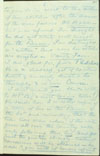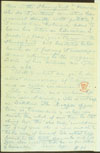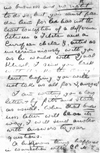Mahatma Letter No. 91: Difference between revisions
No edit summary |
|||
| (6 intermediate revisions by 3 users not shown) | |||
| Line 1: | Line 1: | ||
{{Infobox MLbox | {{Infobox MLbox | ||
| header1 = People involved | | | header1 = People involved | | ||
| Line 11: | Line 7: | ||
| writtendate = unknown | | writtendate = unknown | ||
| receiveddate = October 1882 – see [[Mahatma Letter No. 52#Context and background|below]] | | receiveddate = October 1882 – see [[Mahatma Letter No. 52#Context and background|below]] | ||
| otherdate = | | otherdate = unknown | ||
| header3 = Places | | header3 = Places | ||
| sentfrom = Phari-Jong monastery | | sentfrom = Phari-Jong monastery | ||
| receivedat = [[Simla, India]] | | receivedat = [[Simla, India]] | ||
| vialocation = | | vialocation = unknown{{pad|9em}} | ||
}} | }} | ||
''' | This is '''Letter No. 91''' in''' [[The Mahatma Letters to A. P. Sinnett (book)|''The Mahatma Letters to A. P. Sinnett'']], 4th chronological edition'''. It corresponds to '''Letter No. 110''' in '''Barker numbering.''' See below for [[Mahatma Letter No. 91#Context and background|Context and background]]. | ||
<br> | <br> | ||
<br> | <br> | ||
| Line 32: | Line 28: | ||
{{Col-break|width=55%}} | {{Col-break|width=55%}} | ||
Mr. Sinnett. | Mr. Sinnett. | ||
{{Col-break|width=3%}} | {{Col-break|width=3%}} | ||
| Line 175: | Line 170: | ||
{{Col-end}} | {{Col-end}} | ||
== Page 7 == | == Page 6 & 7 == | ||
{{Col-begin|width=98%}} | {{Col-begin|width=98%}} | ||
| Line 187: | Line 182: | ||
{{Col-break|width=3%}} | {{Col-break|width=3%}} | ||
{{Col-break|width=15%}} | {{Col-break|width=15%}} | ||
[http://www.theosophy.wiki/mywiki/images/ML/91-7.jpg http://www.theosophy.wiki/mywiki/images/ML/91-7_thm.jpg] | |||
{{Col-break|width=30%}} | {{Col-break|width=30%}} | ||
| Line 210: | Line 205: | ||
{{Col-break|width=3%}} | {{Col-break|width=3%}} | ||
{{Col-break|width=15%}} | {{Col-break|width=15%}} | ||
[http://www.theosophy.wiki/mywiki/images/ML/91-8.jpg http://www.theosophy.wiki/mywiki/images/ML/91-8_thm.jpg] | |||
{{Col-break|width=30%}} | {{Col-break|width=30%}} | ||
| Line 219: | Line 214: | ||
== Context and background == | == Context and background == | ||
Phari-Jong (or Phari Dzong) is a fortress in the town Pagri (or Phari), in the Tibet Autonomous Region. This letter was sent from a monastery situated close to the fortress. | |||
== Physical description of letter == | == Physical description of letter == | ||
| Line 236: | Line 231: | ||
== Notes == | == Notes == | ||
<references/> | <references/> | ||
[[Category:ML from Koot Hoomi]] | |||
[[Category:ML needs background]] | |||
[[Category:ML to A. P. Sinnett]] | |||
[[Category:ML with images]] | |||
[[Category:ML needs commentary]] | |||
Latest revision as of 14:52, 7 April 2022
| Quick Facts | |
|---|---|
| People involved | |
| Written by: | Koot Hoomi |
| Received by: | A. P. Sinnett |
| Sent via: | unknown |
| Dates | |
| Written on: | unknown |
| Received on: | October 1882 – see below |
| Other dates: | unknown |
| Places | |
| Sent from: | Phari-Jong monastery |
| Received at: | Simla, India |
| Via: | unknown |
This is Letter No. 91 in The Mahatma Letters to A. P. Sinnett, 4th chronological edition. It corresponds to Letter No. 110 in Barker numbering. See below for Context and background.
< Prev letter chrono
Next letter chrono >
< Prev letter Barker
Next letter Barker >
Envelope
|
Mr. Sinnett. |
|
NOTES:
|
Page 1 transcription, image, and notes
|
My dear friend — May I trouble you to hand the enclosed Rs. 50 to Darbhagiri Nath when you see him? The little man is in trouble but has to be remonstrated; and the best punishment for an accepted chela is to receive the reproof through a "lay" one. On his way from Ghoom to Bengal through imprudence and indiscretion he lost money, and, instead of addressing himself directly to me he tried to dodge the "Master's eye" and called upon a probationary chela upon whom he has not the slightest claim to help him out of his difficulty. So please tell him that Ram S. Gargya has not received his telegram from Burdwan but that it went direct into the hands of the Lama who notified me of it. Let him be more prudent |
|
NOTES:
|
Page 2
|
in future. You now see the danger in allowing young chelas out of sight even for a few days. Money losses are nothing, but it is the results involved and the temptation that are terrible. My friend, I am afraid you too, have been again IMPRUDENT. I have a letter from Colonel Chesney — very polite and quite diplomatic. Several such messages may do for an excellent refrigerator. Yours, P.S. — I am glad to find you reprinting in the Pioneer "A Day with my Indian Cousins" by Atettjee Sahibjee, etc., from Vanity Fair. Last year I had asked you |
|
NOTES:
|
Page 3
|
to give some work, to the author of those sketches after the manner of the once famous Ali Baba — but was refused. You thought he did not write well enough for the Pioneer. You distrusted a "native," and now his articles are accepted in Vanity Fair. I am glad for poor Padshah. He is a madcap, yet of excellent heart and sincerely devoted to Theosophy and — our Cause. I must consult you. Hume writes to H.P.B. (a most loving letter !). He sends her two corrected copies of a letter of his in the Pioneer of the 20th and remarking that the time has come when, if the native press all over the country will only following this, his lead, push the question strongly — material concessions will be obtained — he adds "you will of course reprint |
|
NOTES:
|
Page 4
|
this in the Theosophist." How can she do it, without connecting her journal directly with politics? I would have extremely liked to have his letter on Education reproduced from your Pioneer in the Theosophist, but hesitated to tell her to do it, fearing it would give a new colouring to the magazine. Some of his articles are extremely able. Well, and what are you to do about anniversary of "Eclectic" and cyclic conclusion? She is better and we have left her near Darjeeling. She is not safe in Sikkim. The Dugpa opposition is tremendous and unless we devote the whole of our time to watching her, the "Old Lady" would come to grief since she is now unable to take care of herself. See what happened to the little man — he will tell you. You ought to take her in for October and November. Yours again, |
|
NOTES:
|
Page 5
|
This little wretch forced me to blush before you on account of his indiscretion — "from a European standpoint." I cannot be always looking after my Chelas in their travels — and their knowledge of your ways and usages amounts to cipher! It is but to-day that I learned of his borrowing from you Rs. 30 — through Djual Khool. He had |
NOTES:
|
Page 6
|
no business and no right to do so; but you must pardon him for he has not the least conception of a difference between a Tibetan and a European chela and acted as unceremoniously with you as he would with Djual Khool. I send you back with thanks the money |
NOTES: |
Page 6 & 7
|
lent, hoping you will not take us all for savages! I am writing you a long letter by fits and starts as usual. When that business letter will be on it's way, I will send another with answers to your questions. A ludicrous thing happened in connexion with C. C. M.'s |
NOTES:
|
Page 8
|
letter that I will relate in my next. Hail and success to the "new President" at last!! Yours ever fondly, K. H. Pardon the unavoidable delay. This letter with the enclosed cannot reach Darjeling before 4 or 5 days. |
NOTES: |
Context and background
Phari-Jong (or Phari Dzong) is a fortress in the town Pagri (or Phari), in the Tibet Autonomous Region. This letter was sent from a monastery situated close to the fortress.
Physical description of letter
The original is in the British Library, Folio 3. According to George Linton and Virginia Hanson, the letter was written:
In blue pencil on three sheets of paper, two unfolded, the third one folded. They seem to have been written as three separate notes, probably on different days. It is not clear why they were grouped together by the editor as one letter.[1]
Publication history
Commentary about this letter
Notes
- ↑ George E. Linton and Virginia Hanson, eds., Readers Guide to The Mahatma Letters to A. P. Sinnett (Adyar, Chennai, India: Theosophical Publishing House, 1972), 151.








